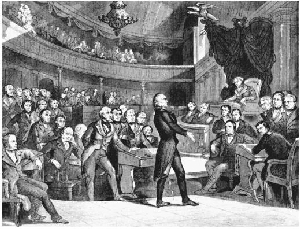- The past may very well forecast our future.
Click for AUDIO VERSION.
To use this segment in a Radio broadcast or Podcast, send TIM a request.
 Some time ago, I happened to make a comparison between the period leading up to the American Civil War (1820-1860) and the discourse of today. I wish to take this a bit further so people can better understand the parallel.
Some time ago, I happened to make a comparison between the period leading up to the American Civil War (1820-1860) and the discourse of today. I wish to take this a bit further so people can better understand the parallel.
Back in the early 1800's, the country was still divided over the question of slavery, primarily along sectional lines, north versus south. As the young country began to expand in a westerly direction, both sides grew concerned over losing power in Congress through the annexation of new states on either side of the slavery issue. If one side gained more votes than the other, it was conceivable they could implement policies and laws detrimental to the other side. Although there was initially balance between the states, a flash point erupted when the citizens of Missouri applied for statehood as a slave state. This led to an impasse in both houses of Congress as the discourse heated up. The debates were so passionate they began to draw large audiences in the galleries. Both sides were adamant in their position and settlement of the issue seemed impossible.
After several attempts, the Missouri Compromise was finally drafted whereby Missouri would be allowed to join the country as a slave state, and Maine, which had been a part of northeastern Massachusetts, was admitted as a free state, thereby maintaining parity over Congress. Further, an amendment was added whereby slavery would be excluded in all territories and future states north of the parallel 36°30' north (the southern boundary of Missouri).
The compromise was a clumsy document and only delayed the inevitable dispute over slavery. Former President Thomas Jefferson believed it would eventually lead to the destruction of the Union. He summed up the sentiments of the day in a letter to his friend, John Holmes on April 22, 1820; Jefferson wrote:
"...But this momentous question, like a fire bell in the night, awakened and filled me with terror. I considered it at once as the knell of the Union. It is hushed indeed for the moment, but this is a reprieve only, not a final sentence, a geographical line, coinciding with a marked principle, moral and political, once conceived and held up to the angry passions of men, will never be obliterated; and every new irritation will mark it deeper and deeper."
For the next thirty years, both sides carefully watched the balance of power. In 1836 when Michigan was admitted as a free state, Arkansas was admitted as a slave state. The Compromise of 1850 dealt with the admittance of Texas and consideration for states in the southwest, including California.
It wasn't until the passage of the Kansas–Nebraska Act of 1854, drafted by Senator Stephen A. Douglas of Illinois, that the Missouri Compromise was finally made obsolete. Under the Act, the voters of each state would determine the issue of slavery internally, not by the Congress, thereby negating the intent of the Missouri Compromise. Although the Act was intended to appease both sides, it was ultimately perceived as supporting the slave powers of the South.
The debate over the Act went on for four months and featured the political luminaries of the day, including Douglas, Salmon P. Chase (OH), William Seward (NY), and Charles Sumner (MA). The New York Tribune wrote on March 2nd that, "The unanimous sentiment of the North is indignant resistance," which sounds remarkably like Congress today.
The Kansas-Nebraska Act eventually passed but set the country on a course towards Civil War. In the process, it caused chaos among the political parties which were split up and redefined. For example, it gave rise to the Republican Party in 1856 which primarily consisted of northerners who were antislavery.
PARALLEL
Both disputes, then and now, are cultural in nature. Whereas slavery was the issue driving the disagreements of the early 1800's, today it is socioeconomics. Both issues were extremely divisive and incongruous to the point of being irreconcilable. Today's discourse is every bit as bitter and reminiscent of the period preceding the Civil War, and the void between the two sides is just as large and insurmountable. Again, it is all about control over the Congress and which side will force their way of life on the other.
If the Missouri Compromise and Civil War has taught us anything, the only way such sharp disputes can be resolved is through armed conflict. This is not only a scary proposition for the country internally, but it would have far reaching effects on the world at large, as it would finally present the opportunities our enemies have been waiting for in order to dismantle the free world.
I sincerely hope nobody truly wants armed conflict as we should have learned this lesson through our first Civil War, but the divisiveness of the country makes you wonder how we can possibly avoid it. Let us not forget, the period leading up to the Civil War spawned zealots like abolitionist John Brown who advocated and practiced armed insurrection. You have to wonder who will be the zealot of our time.
First published: June 18, 2010. Updated 2019.
Keep the Faith!
Note: All trademarks both marked and unmarked belong to their respective companies.
 Tim Bryce is a writer and the Managing Director of M&JB Investment Company (M&JB) of Palm Harbor, Florida and has over 40 years of experience in the management consulting field. He can be reached at timb1557@gmail.com
Tim Bryce is a writer and the Managing Director of M&JB Investment Company (M&JB) of Palm Harbor, Florida and has over 40 years of experience in the management consulting field. He can be reached at timb1557@gmail.com
For Tim's columns, see: timbryce.com
Like the article? TELL A FRIEND.
Copyright © 2019 by Tim Bryce. All rights reserved.
Listen to Tim on WZIG-FM (104.1) in Palm Harbor,FL; Or tune-in to Tim's channel on YouTube. Click for TIM'S LIBRARY OF AUDIO CLIPS.
No comments:
Post a Comment